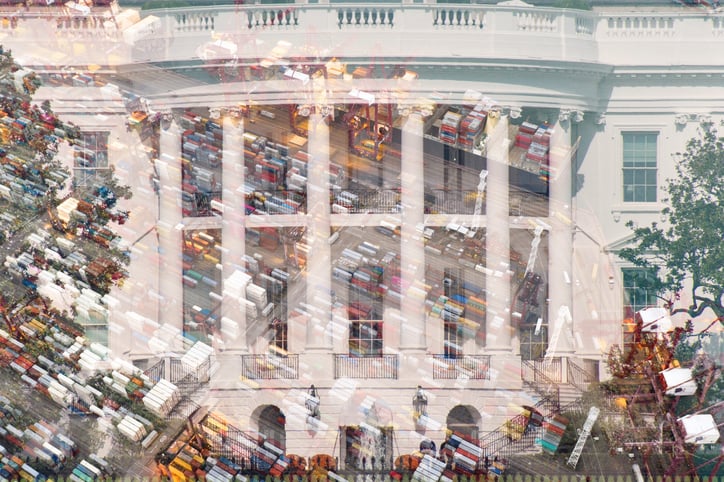Liberation or Disruption? Only Time Will Tell

The long anticipated “Liberation Day” is on Wednesday.
Dubbed as such by President Donald Trump, it is the day he is expected to roll out “reciprocal” and perhaps widespread tariffs on a multitude of countries — trading partners — that contribute to the U.S. trade deficit, which reached US$1.2 trillion in 2024.
Will it be Liberation Day or something else? “On Wednesday, Trump will unleash a new round of global trade wars,” a Washington Post opinion piece states. White House aide Peter Navarro expects the tariffs to generate $6 trillion in revenue over the next 10 years — that’s $600 billion a year — “which could amount to the largest tax hike in U.S. history,” CNN reported.
Supply managers will be glued to their phones and laptops awaiting the announcement, to determine how and how much their supply chains will be impacted. Much is unknown: Will the tariffs be across the board, on all items and all countries? What does reciprocal mean? Is any country potentially “safe,” as in free from tariffs? How will organizations manage the inevitable price increases on tariffed components, parts and goods? Will the tariffs rollout hasten a recession? How will customers and consumers be impacted?
The Potential Targets
What is known: Trump’s views on tariffs. “The president will be announcing a tariff plan will roll back the unfair trade practices that have been ripping off our country for decades,” White House press secretary Karoline Leavitt told reporters on Monday. “He’s doing this in the best interest of the American worker.”
The president has said reciprocal tariffs or tariffs in general helps boost American manufacturing and create new jobs. “A 2024 economic analysis found that a global tariff of 10 percent would grow the economy by $728 billion, create 2.8 million jobs, and increase real household incomes by 5.7 percent,” a White House fact sheet states.
Other countries have been exacting tariffs on a variety of U.S. goods for years, Trump often notes. Trump told reporters over the weekend, “The tariffs will be far more generous than those countries were to us, meaning they will be kinder than those countries were to the United States of America. Over the decades, they ripped us off like no country has never been ripped off in history and we’re going to be much nicer than they were to us, but it’s substantial money for the country."
Leavitt continued that tariffs on U.S. goods make “it virtually impossible for American products to be imported into these markets and it has put a lot of Americans out of business and out of work over the past several decades.”
Among the potential targeted countries and tariffs:
India, which imposes 50 percent to 100 percent tariffs on certain foods and requires specific licenses and approvals for doing business in the country.
Canada. In early March, Trump implemented 25 percent tariffs on goods imported from Canada, although those levies were largely suspended within 48 hours and given a 30-day reprieve. That reprieve is up on Wednesday. There is speculation that Canada will not be given another delay.
Another dynamic often mentioned by the Trump Administration: U.S. dairy products are subject to a 200 percent to 300 percent levy by Canada. But that’s only if they go over a certain amount, which has yet to happen, a CNN article states.
Mexico. Border concerns — Mexicans illegally entering the U.S. and fentanyl trafficked into the U.S. — may prompt a tariff rollout. As with Canada, goods imported from Mexico were hit by a 25-percent tariff, which also was largely suspended until Wednesday. Mexican president Claudia Sheinbaum has taken a “wait and see” attitude about Trump-imposed tariffs.
Other regions, countries and goods that could be tariffed include:
- The European Union, Brazil, Japan and South Korea
- Pharmaceuticals and wine
- Countries that buy oil and gas from Venezuela.
Don’t Forget Auto Tariffs
Trump also has announced a 25-percent tariff on U.S. auto imports and certain auto parts that is slated to take effect on Thursday, impacting a sector that was hit by a 25-percent tariff imposed on imported steel and aluminum in mid-March.
Such a levy “could cost importers $76 billion a year if import levels remain consistent year over year,” Dun & Bradstreet Analytics said in a statement. “Mexico, Japan, South Korea, Canada and Germany are expected to most impacted by these tariffs, as manufacturers in these countries produce 81.2 percent of U.S. auto imports. Other countries with smaller but still appreciable (greater than 1 percent) share of imports include China, the United Kingdom, Slovakia, Italy and Sweden.”
The New York Times reported that a Trump senior trade adviser maintains the auto tariffs will raise $100 billion, “which would translate to tax credits for people who buy American cars.”
However, many American cars contain imported parts. Various estimates speculate that car prices could go up $3,500 to $10,000, perhaps even more.
Anderson Economic Group estimates that “cost increases could hit in-demand models within a month. For other models with substantial inventory, cost increases could be delayed by 2 months or more. It is also likely that manufacturers of some low-volume models will stop importing them into the U.S. market entirely.”
Still, the White House fact sheet states, “These new tariffs aim to ensure the U.S. can sustain its domestic industrial base and meet national security needs.”
***
Even after “Liberation Day,” many questions will remain. Will the tariffs bring manufacturing back to the U.S.? Are there U.S. companies that can produce and supply the components now being imported? Will the enactment of tariffs create more jobs? Will tariffs contribute to a recession? Will stock markets, which have experienced volatility in response to the impending tariffs announcement, return to normal soon? Will customers and consumers be priced out of the auto market? How will this impact global trade, relationships and partnerships?
Only time will tell.


